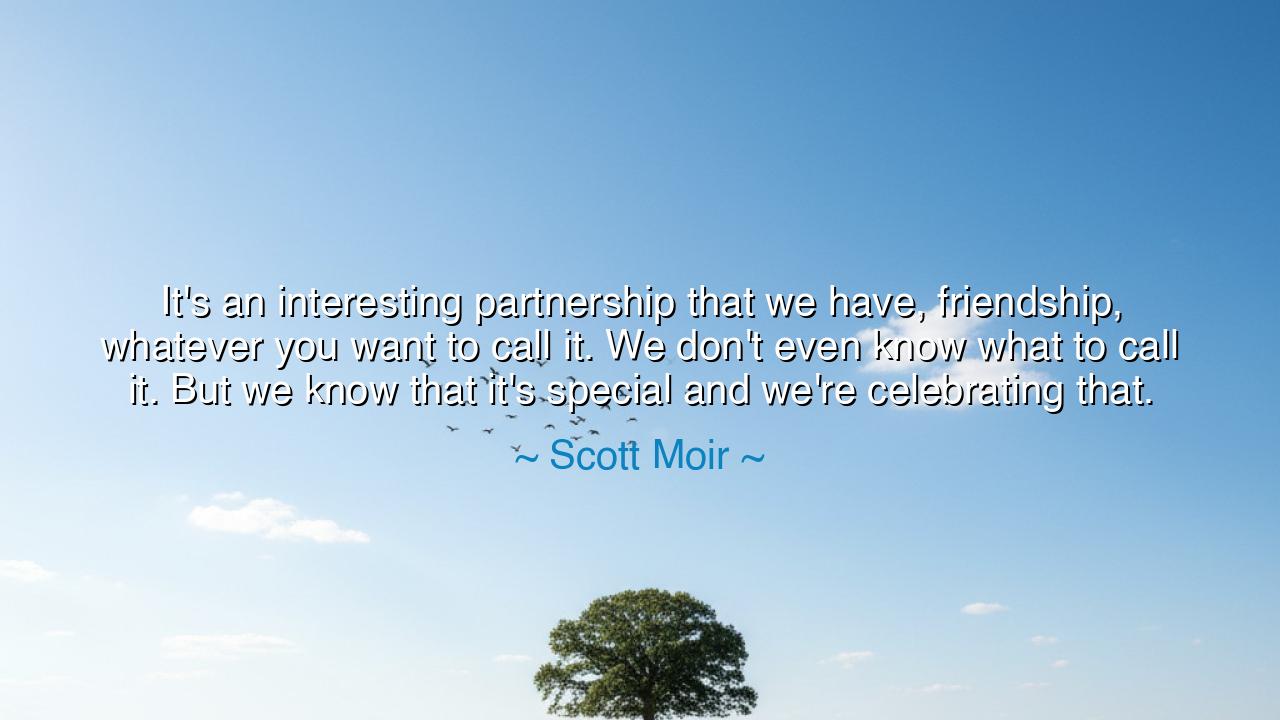
It's an interesting partnership that we have, friendship
It's an interesting partnership that we have, friendship, whatever you want to call it. We don't even know what to call it. But we know that it's special and we're celebrating that.






Hear the thoughtful words of Scott Moir, champion ice dancer and artist of grace, who said: “It’s an interesting partnership that we have, friendship, whatever you want to call it. We don’t even know what to call it. But we know that it’s special, and we’re celebrating that.” These words, though born from the shimmering world of sport and performance, reach far deeper than the rink. They speak of a connection beyond definition — that mysterious bond between souls who share a path so closely that names cannot contain its depth. Moir, speaking of his legendary partnership with Tessa Virtue, touches here upon the universal truth that some relationships transcend category. They are neither simply friendship nor romance, but something rarer: a harmony of spirit, a sacred balance of trust, respect, and shared creation.
Scott Moir and Tessa Virtue began skating together as children, growing side by side through years of discipline, triumph, and trial. Over two decades, their partnership became one of the greatest in the history of ice dancing, earning them Olympic gold and the admiration of millions. Yet when asked what bound them together, Moir confessed that even they could not name it. This is the beauty of his words — their humility before something greater than explanation. He calls it an “interesting partnership,” a friendship, a connection so profound that language itself falls short. For there are some bonds the heart understands that the tongue cannot describe.
The ancients knew this mystery well. Aristotle spoke of friendship as one of the highest virtues, a relationship rooted not in utility or pleasure, but in goodness — a mutual striving toward excellence. Yet even Aristotle’s wisdom would have struggled to define what Moir and Virtue shared, for theirs was not only moral or emotional, but artistic and spiritual. They were two souls moving as one — a living metaphor for what happens when trust reaches its purest form. To skate in such harmony is to surrender ego, to move not as self, but as we. It is this surrender, this union of will and heart, that Moir celebrates as “special.”
In truth, such bonds have existed across time, wherever two have labored, dreamed, or created together. Think of Michelangelo and his apprentice Urbino, whose understanding transcended words, or of Wilbur and Orville Wright, whose shared vision lifted humanity into the sky. Their relationships were not born of ordinary affection, but of shared purpose — that sacred fire that burns between companions who see the same dream. So too with Moir and Virtue: their ice became the temple of their communion, their movement a prayer to the beauty of human connection.
Moir’s words also carry a deeper wisdom about humility and acceptance. In an age obsessed with labels — with defining, claiming, and classifying every bond — he reminds us that not all connections can or should be confined. The heart knows what it feels, even when the mind cannot name it. To say, “We don’t even know what to call it,” is not confusion but reverence. It is the recognition that some things are too sacred for definition — that love, in its purest form, does not always fit into the narrow molds of “friend,” “partner,” or “lover.” It simply is, and that is enough.
And yet, notice the joy in his final words: “We’re celebrating that.” Here lies the lesson — that the greatest response to a connection we cannot define is not anxiety, but gratitude. To celebrate what is special without needing to label it is the mark of a soul that trusts life’s mysteries. Moir and Virtue did not attempt to explain their bond for the world; instead, they honored it through their art, their discipline, and their enduring mutual respect. They teach us that when something beautiful defies reason, it should not be dissected, but cherished.
The lesson, then, is timeless: not every sacred bond in life will fit the definitions others demand. Some friendships will feel like love; some loves will rest in friendship; some partnerships will carry the weight of both. Do not rush to name what your heart already knows. Instead, live it, nurture it, and, like Moir, celebrate it. The truest connections are not those that can be defined, but those that endure without needing to be.
So, dear listener, when you find someone whose presence completes your rhythm — a friend, a companion, a kindred soul — hold that bond gently. Do not trouble it with labels. Let it flow like Moir and Virtue on the ice — graceful, trusting, alive. For the greatest relationships, whether in art or in life, are not those that the world can easily describe, but those that remind us what it means to be human — to move together, to believe together, and to call the nameless sacred “special.”






AAdministratorAdministrator
Welcome, honored guests. Please leave a comment, we will respond soon